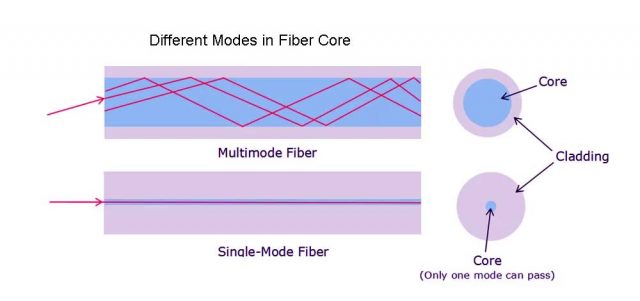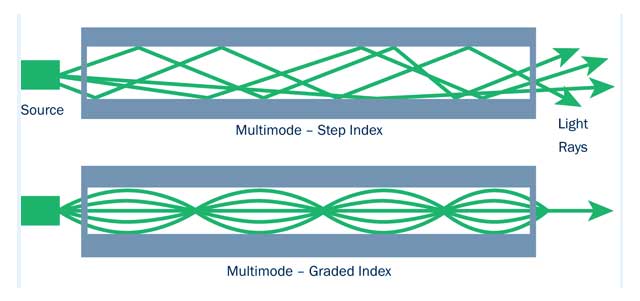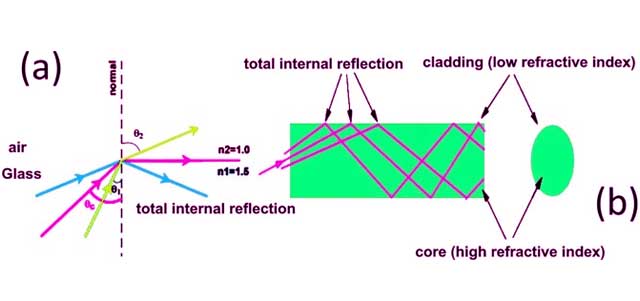A fiber-optic cable is made up of optical fibers, which can range in number from two to several hundred. Linden Photonics fiber-optic cables are made of extremely thin strands of glass or plastic. These optical fiber cables use optical or light-based technology to transmit data between two locations. The light beams would exit the optical fiber cable (OFC) at the opposite end after traveling down it. To convert the light pulses into electrical information that the computer can understand, a photoelectric cell will be needed.
Fiber optic cables are a type of network cable that contains strands of glass fibers inside an insulated casing. They are designed for long-distance, high-performance data networking, and telecommunications. Compared to wired cables, fiber optic cables provide higher bandwidth and transmit data over longer distances.
Light repeatedly hits the walls as it travels down the fiber optic cable. Due to the extremely shallow angles at which it strikes the glass, the light beam does not escape through the edges. Then, as if the glass were a true mirror, it reflects. We call it complete internal reflection. The cable structure is another element that keeps it inside the pipe.
The main benefits of fiber cable are its increased bandwidth and reach. Due to their ability to deliver high-speed broadband services, optical fiber cables (OFC) are now favored over outdated copper telecom cables. Over 100 meters, copper wires lose 94% of the signal while optical fiber only loses 3%. Additionally, optical fibers last longer than copper wires, which are significantly more brittle. While optical fibers do not emit signals that can be intercepted, copper wire is very easy to tap. When compared to copper wires, optical fiber provides much lower latency (the amount of time needed to perform data transmission).
Types of Fiber optics cable
According to the number of modes and refractive index, optical fiber is typically divided into two groups. The following gives the justifications for these.
Based on the number of modes:

It is divided into two categories:
- Single-mode fiber
A single kind of light ray can only move through a single-mode fiber. The refractive index difference between the core and cladding of this type of fiber optic, which has a small core diameter (5 um) and a high cladding diameter (70 um), is incredibly small.
No signal degradation occurs as the signal travels through the fiber because there is no dispersion. A laser diode is used to transmit light through it.
- Multimode fiber
This type of fiber allows a lot of different light-ray modes to pass through it. Typically, the core diameter is (40 um) and the cladding diameter is (70um). Compared to single-mode fiber, the relative refractive index difference is also greater. Multimode dispersion leads to signal degradation. Due to significant signal attenuation and dispersion, long-distance communication is not feasible. Step Index Fiber and Graded Index Fiber are the two classifications for multi-mode fiber. Essentially, these are divisions of optical fiber types based on refractive index.
Based on the refractive index

It is further divided into two categories:
- Step-index optical fiber
The core’s refractive index is constant. The cladding’s refractive index is also constant. When reflected at the core-cladding boundary, the light rays travel through it as meridional rays that cross the fiber axis.
- Graded index optical fiber
In this kind of fiber, the core’s refractive index is not uniform and gradually decreases from the center outward to the core-cladding interface. The refractive index of the cladding is consistent. Skew or helical light rays travel through it as they move through a material. At no point does it cross the fiber axis.
How does it work?
Numerous optical fibers, which are very thin strands of glass or plastic that are less than one-tenth the thickness of a human hair, are used to make fiber-optic cables. Data is transmitted over fiber-optic cables using light pulses that travel quickly. The central fiber is encircled by yet another layer of glass, referred to as the “cladding,” which causes light to repeatedly bounce off the walls of the cable instead of leaking out at the edges, allowing the single to travel further without attenuation. This process is called Total Internal Reflection.

Applications for various optical fiber types
The use of optical fiber has shown advantages over traditional metallic wires.
Optical fiber communication applications
- Medical industry: Due to its flexibility and thinness, it is used in several instruments to view internal body parts by slipping into hollow body cavities. Fiber lasers are used in surgical lasers, endoscope lasers, microscope lasers, and biomedical lasers.
- Communication: Since optical fiber cables are used for both transmission and reception, they are crucial to the fundamentals of optical fiber communication systems. It can be used in a variety of networking applications to increase speed and precision.
- Défense: Fiber optics are used to transfer data in high-security military and aerospace applications. This material is used in aviation wiring as well as hydrophones for SONAR and seismic applications.
- Broadcasting: These cables transmit HDTV signals at a high speed and bandwidth. Fiber optic cable is more affordable than the same number of copper cables. In order to connect HDTV, CATV, VOD, and other services, broadcasters use optical fibers.
- Decorations and lighting: Now that we are aware of what optical fiber is, we can understand why it is used so frequently in Christmas trees and decorations. It is affordable, simple to use, and gorgeous.
FAQs
- What is a Fiber Optic Cable?A fiber optic cable is a network cable made up of glass fibers, each about as thick as a human hair, that can transmit data as light pulses. They are known for their speed, reliability, and efficiency in data transmission.
- How Do Fiber Optic Cables Work?
Fiber optic cables work by transmitting light signals through the glass fibers. The light is encoded with data, which travels through the cable by a process of total internal reflection, ensuring minimal loss of signal over long distances.
- What Are the Main Types of Fiber Optic Cables?There are two main types of fiber optic cables: single-mode and multi-mode. Single-mode fiber optic cables are used for long-distance communication, while multi-mode fibers are used for shorter distances.
- What Are the Advantages of Fiber Optic Cables?High Bandwidth: They support higher data rates.
Long Distance: They can transmit data over longer distances without significant signal loss.
Resistance to Interference: Immune to electromagnetic interference.
Security: Harder to tap into without being detected.
- Where Can I Use Fiber Optic Cables?
Fiber optic cables are commonly used in internet connections, telecommunications, medical imaging, and networking between computers.
Buying Guide for Fiber Optic Cables
When purchasing fiber optic cables, consider the following factors to ensure you get the right product for your needs:
- Type of Cable
Single-mode: Best for long distances and higher bandwidth needs.
Multi-mode: Suitable for shorter distances and more cost-effective for general use.
- Cable Jacket Type
Indoor Cables: Less robust, suitable for internal installations.
Outdoor Cables: More durable, weather-resistant, and often armored for protection.
- Cable Length
Measure the distance between your connection points to determine the necessary length. It’s better to have a slightly longer cable than to come up short.
- Connectors
Ensure compatibility with your devices. Common types include LC, SC, ST, and MTP/MPO connectors.
- Bandwidth Requirements
Determine the bandwidth your application requires to choose the appropriate cable type and specifications.
- Price vs. Quality
While budget is important, consider the long-term performance and reliability of the cable.
- Brand Reputation
Opt for reputable brands like Linden Photonics, known for their high-quality fiber optic solutions.
Where to Buy Linden Photonics Fiber Optic Cables
Linden Photonics’ fiber optic cables are available through various channels. Here are some recommended options:
- Official Website
Purchase directly from the Linden Photonics website for the full range of products and the latest offerings.
- Authorized Distributors
Check the list of authorized distributors on the Linden Photonics website to find reliable sellers.
- Online Retailers
Websites like Amazon, Newegg, and other tech-specific online retailers often stock Linden Photonics products.
Categories of Fiber Optic Cables by Linden Photonics
- Single-Mode Fiber Optic Cables
Ideal for long-distance telecommunications and high-speed internet connections.
- Multi-Mode Fiber Optic Cables
Perfect for shorter distances, such as within a building or campus network.
- Armored Fiber Optic Cables
Designed for outdoor and harsh environments, offering additional protection against physical damage.
- Specialty Fiber Optic Cables
Custom-designed cables for specific applications, including medical, military, and industrial uses.
- Fiber Optic Accessories
Connectors, adapters, and other accessories to complete your fiber optic network setup.
Fiber optic cables are essential for modern high-speed data transmission and telecommunications. Understanding the types of cables, their advantages, and how to choose the right one for your needs is crucial. Linden Photonics offers a wide range of high-quality fiber optic cables and accessories to meet various requirements. Whether you’re setting up a home network, enhancing your business’s communication infrastructure, or needing specialized cables for unique applications, Linden Photonics has the products and expertise to help you succeed.
For more information and to browse our products ot Contact Linden Photonics to get a quote or Call Us at (978) 392-7985

